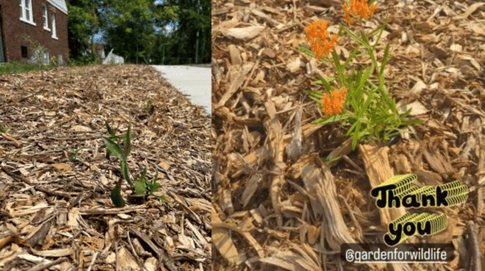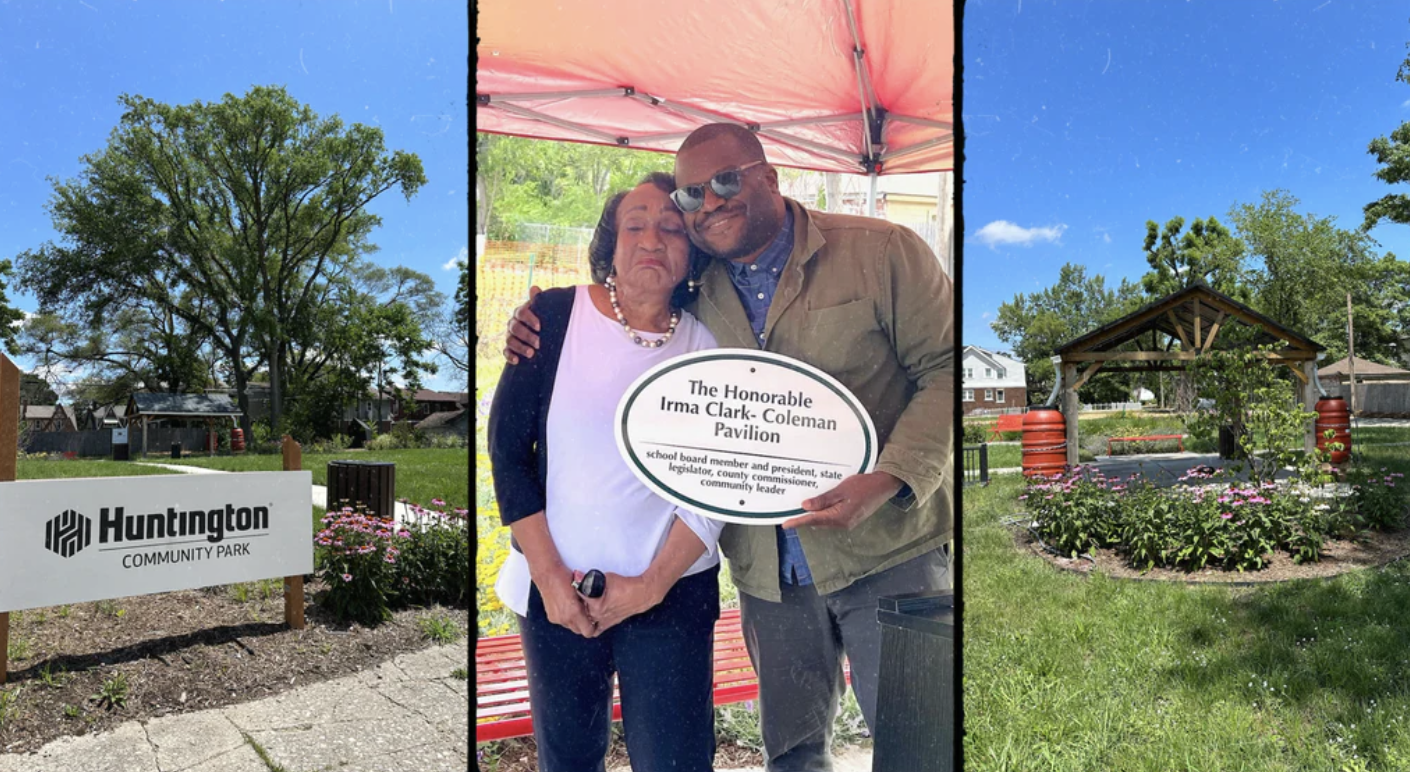Abandoned Buildings Turned Habitat for Pollinators
Thanks to its motivated residents, empty lots on two different streets within the Detroit Marygrove neighborhood have now taken on new life with many native plants and other features to enjoy. Local wildlife, including critical pollinators, will benefit from the new Michigan native plants. Many volunteers made light work of planting over 400 native plants donated by Garden for Wildlife at the end of June.

On Indiana Street, the newly installed native plants join existing vegetable gardens and a communal space often utilized to host neighborhood association meetings, and a community market. Residents are welcome to pick and use the seasonal offerings.

One street over, on Kentucky Street, a brand new park is named after Huntington Bank, which contributed $49,000 to its development. It spans 3 residential lots. Wayne County also donated $47,000, while the design came from a grant from the Detroit Collaborative Design Center at the nearby Detroit Mercy School of Architecture. The newly planted pollinator pathway of native plants on Kentucky will extend this urban corridor of wildlife oasis.
During the ribbon cutting ceremony at Huntington Park, a new pavilion was dedicated to Wayne County Commissioner Irma Clark-Coleman as recognition of her lifetime of public service and for being a champion for communities such as Fitzgerald. The new park is in her district. Detroit FOX 2 captured her sentiments: “Members of the Marygrove Community Association have long sought this new park and I am pleased to have been able to work with them to make it a reality. To give this struggling neighborhood a shot in the arm toward revitalization is critical. Residents will see these beautiful improvements to their neighborhood and want to do more themselves. Creating a greenspace will give the community that shot in the arm. Just as blight spreads, so does restoration,” Commissioner Clark-Coleman said. We know that humans and wildlife will both enjoy these new spaces.

Detroit Neighbors & Volunteers Key to Garden Success
Marygrove Community Association members Fred & Valarie Watkins, Jay Meeks, and Stefania Daigler were key to the success of these projects. From acquiring the former residential lots, cleaning up, to planting in the hot heat of the Michigan sun, the neighbors are years into transforming what used to be vacant buildings. Stefania shared some of that vision with us.
- What was the motivation behind incorporating native plants? Primarily looking to beautify our new spaces with something that is low maintenance and will continue to thrive year over year. We did want to ensure whatever we were planting made sense for the area, avoiding invasive species and such, so we focused on incorporating native plants.
- Were there any challenges or considerations you faced when incorporating the native plants into the garden? No particular challenges when incorporating - we were fortunate to have plenty of volunteers to get the work done in a weekend. Additionally, we had the funding to be able to acquire mulch and top soil, but that would likely be challenging for other communities that might now have the resources.
- What advice would you give other neighborhoods or associations about starting their own community garden space? Volunteers is the key! Regardless of the size of the donation, many hands will be needed to get the work done in a reasonable time as well as immediate maintenance after planting. We will be taking turns watering in the first few days/weeks to ensure the plants do thrive. Additionally, spend time preparing the planting area prior to planting day
- What does the future hold for each space? So much potential! Aside from making our spaces beautiful, we're welcome more wildlife and encouraging people to make similar changes.
We’ll be sure to check back in on the new garden spaces as the plants grow.
Detroit Neighborhood Vision for a Sustainable Future
Spaces like this built by residents should serve as an inspiration for other communities interested in planting with a purpose. By embracing native plants and prioritizing biodiversity, we can cultivate vibrant ecosystems within our cities. Each individual's contribution, no matter how small, makes a significant difference in preserving wildlife and creating sustainable environments.
Some homeowners face challenges with HOA rules or restrictions, but modernizing these old-school rules is a case worth making. An easy way to start is to discuss the benefits of No-Mow May - an initiative to pause spring cleanup long enough to allow pollinators to emerge. If you’ve already planted native plants and installed a water feature, be sure you’re maintaining your green space with sustainable practices. Even small spaces like balcony or patio gardens are filled with possibilities.
More and more communities are planting with a purpose: to help disappearing monarch butterflies, bees, songbirds and other wildlife and to reconnect their cities to the local ecosystem. National Wildlife Federation and Garden for Wildlife call on cities, their citizens and local governments to plant native. These efforts are more important than ever as we work to combat the extinction crisis.
How to Apply for a Community Plant Donation from Garden for Wildlife
By simply purchasing a plant, individuals are actively participating in the preservation of biodiversity in their own gardens, and in a community garden or public space. The donation program enables the creation and maintenance of wildlife habitats and educates and engages communities across the country. And twice as many birds, bees, butterflies, and other important wildlife species have the food and shelter they need to survive.
We’re excited to help more communities get more native plants in the ground in as many places as we can. Learn more about this program.

